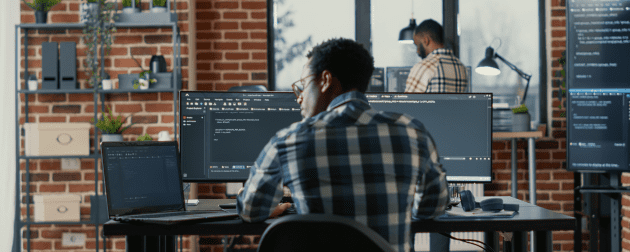What is the Software Development Lifecycle (SDLC) if not where process optimization meets product excellence? Although it can be easy for organizations to become desensitized and run through the motions automatically, putting critical thinking into what is done – and how – is a strategic necessity. A finely tuned SDLC isn’t just about hitting deadlines; it’s about crafting products that users adore and rely upon. It’s about adjusting the team roles and routines to ensure top-notch quality, on-time deliveries, and budget adherence. If done well, it can be a driving force behind enhanced user experiences, robust system reliability, and ultimately, improved profitability. Join us as we visit the intricate stages of SDLC, and unveil the critical roles, responsibilities, and improvement avenues in each step.
[ez-toc]First things first: let’s look at what SDLC models and frameworks are most commonly used and why they are fitting for different company and team contexts.
Software Development Lifecycle Models: Navigating the Options

And more: besides being highly useful for creating, maintaining, and fixing digital products, Software Development Lifecycle (SDLCs) are perfect for increased cooperation between participants and improving resource management and cost-effectiveness. Its importance seems obvious; yet, achieving good results is quite rare in the technology market.
- A study by the Standish Group International on the efficiency of IT projects revealed that 88% of the initiatives are delayed on schedule, in which case the average delay compared to the initial schedule is an impressive 222%.
- And gets even worse: considering all the projects that were delivered late and at a higher cost, only 61% of the features initially planned are properly delivered to customers.
When it comes to managing the complex journey from conceptualization to launch, various SDLC models provide structured paths to success. Although each nuanced model offers specific strengths and weaknesses, they aren’t mutually exclusive. You can mix and match per team or product, or implement your own variation to match temporary company needs.
[table id=5 /]So which SDLC model is better? The Answer is classic: “It depends!“. Selecting the right model depends on your project’s unique characteristics, team capabilities, and business goals. Dive deeper into each model to discover the one that aligns best with your project’s needs and aspirations.
While these SDLC models vary in their approaches, they share common traits that underscore their effectiveness. To demystify these models, we’ll break down their core steps into five shared elements, each receiving varying degrees of emphasis depending on the chosen model. These shared steps serve as the foundation upon which each SDLC model builds its unique framework, ensuring that regardless of your choice, you navigate your software development journey with clarity and purpose.
How to Yield Better Results at Each SDLC Stage
Step 0: Identify Problems to Be Solved – Setting the Foundation for Success

In the initial phase of the Software Development Lifecycle (SDLC), teams identify the problems that the forthcoming software or feature will address. This step is pivotal because it lays the groundwork for the entire project. It involves meticulously scrutinizing user needs, pain points, and expectations.
Understanding ‘why’ the software is needed and ‘what’ issues it will resolve is the bedrock upon which successful software development is built.
“Start by solving the right problem. This is the most important step.” – Gregor Hohpe
Identifying problems to be solved matters because it ensures that the software aligns with real-world needs, reducing the risk of building features or functionalities that have limited or no value.
To make sure all team members know exactly what to do, it is important to agree on terms and conditions, establishing internal service level agreements (SLAs). These don’t need to be formal documents – a simple chat (or ticket, or Slack message) with overall scope, requirements, and metrics to measure performance and effectiveness are enough. Don’t forget to register what the Definition of Done (DoD) is.
[table id=6 /]The core takeaway here is to involve cross-functional teams and conduct extensive user research to ensure a comprehensive problem-identification process.
For instance, Project Sponsors can set an SLA for user engagement, requiring regular feedback sessions to validate problem statements. Such practices ensure that the software development journey begins on a solid foundation of understanding and addressing real-world challenges. To drive the point home, here are some SLA examples:
Example 1:
- Who: Business Analysts
- What: Define problem statements and requirements
- When: Within the first two weeks of project initiation
- Why: Ensures early and accurate problem identification
- How: Conduct user interviews, surveys, and research to gather comprehensive data.
- DoD: Problem statements and requirements documented and approved by stakeholders. DoD includes at least 80% coverage of identified user needs.
Example 2:
- Who: Project Sponsors
- What: Provide feedback on problem statements
- When: Within one week of problem statement submission
- Why: Ensures alignment with organizational goals
- How: Review problem statements and validate their strategic relevance.
- DoD: Feedback provided with specific recommendations for revisions or approvals granted. DoD includes documented alignment with the company’s strategic objectives.
Makes sense?
Step 1: Planning and Preliminary Analyses – Setting the Project’s North Star

During this phase, teams come together to define the project’s scope, objectives, and strategy. This stage resembles charting a course for a journey. Without a well-constructed plan, there’s a risk of aimless wandering.
“The best way to predict the future is to create it.” – Peter Drucker
This step is essential because it establishes the project’s direction and ensures that every participant comprehends the project’s purpose, resource requirements, and the roadmap to follow. It’s more productive for all stakeholders if Business Analyst and the Project Manager gather the necessary skills to find a good solution to solve a user problem with reasonable technical feasibility.
[table id=7 /]If everyone knows the direction they should go to, they can all, individually, channel their expertise to reach it. To avoid misconceptions, engage all pertinent stakeholders, meticulously define project scope, and craft a robust project plan.
When Step 1 unfolds seamlessly, the result is a well-defined plan that aligns all participants toward a common goal. For example, Project Sponsors can guarantee resource allocation, ensuring that the project has the requisite personnel and budget for progression. Others agreements can look like:
Example 1:
- Who: Project Managers
- What: Create a project plan with defined milestones
- When: Within two weeks of project initiation
- Why: Establishes a clear project roadmap
- How: Collaborate with cross-functional teams to outline project phases and timelines.
- DoD: Project plan finalized, reviewed, and approved by relevant stakeholders.
Example 2:
- Who: Product Owners
- What: Prioritize project objectives and requirements
- When: Before the start of the development phase
- Why: Ensures that project focus remains user-centric
- How: Review and rank objectives based on user needs and business impact.
- DoD: Prioritized objectives and requirements documented and approved, with a clear understanding of the order of importance.
As you can see, although the roles may seem intuitive to the team member (it’s often part of the job description), exact deliverables aren’t always as intuitive. Evidencing these in documentation, tickets, timelines or reports can be super valuable.
Step 2: Designing Product Architecture – Blueprinting Excellence

How to design, make, sell, use, and repair a new product? In this stage, the team involved must create and cluster the scheme to allocate physical components of the product, draft a layout, and identify fundamental and incidental interactions involved.
In the second stage of the SDLC, the project’s architectural framework takes shape. Just as an architect designs the blueprint for a building, this phase involves crafting the technical structure of the software. It’s about defining how all the components fit together, both physically and functionally. In this context, doing the right thing means creating an architecture that aligns with the project’s objectives and scalability requirements.
[table id=8 /]This possibly requires teamwork more than any other step. A well-architected product not only meets immediate requirements but also paves the way for future growth. As usual, clear communication and documentation are key to success, but even more so when making architectural decisions that will have a long-term impact. So what do these SLAs look like?
Example 1:
- Who: Technical Leads
- What: Define the technical architecture
- When: Within the first two weeks of project initiation
- Why: Ensure alignment with scalability and security requirements
- How: Collaborate with the architecture team to create architectural diagrams and documentation
- DoD: Technical architecture finalized and reviewed by the architecture team, with documented scalability and security considerations.
Example 2:
- Who: Frontend and Backend Engineers
- What: Collaborate to ensure seamless integration
- When: Before the start of the coding phase
- Why: Ensure consistency and compatibility between frontend and backend components
- How: Regular communication and code reviews between frontend and backend teams
- DoD: Frontend and backend components integrated and tested for compatibility, with documented integration processes.
Example 3:
Who: DevOps Engineers
- What: Establish SLAs for continuous integration and deployment (CI/CD) pipelines
- When: At the beginning of the design phase
- Why: Streamline the development process and ensure rapid deployment
- How: Define CI/CD pipeline processes and automate deployment steps
- DoD: CI/CD pipelines established, documented, and automated, with successful deployment of initial project components.
All the software requirements specifications should be registered in the SRS document, describing software features and performance. It keeps everyone on the same page.
When Step 2 is executed effectively, it results in an architectural blueprint that provides a solid foundation for development, aligns with scalability needs, and incorporates security measures. Technical Leads, for example, should ensure that the architecture can accommodate increasing user loads without performance degradation.
Step 3: Coding – Transforming Vision into Reality

In this hands-on phase, the development team takes the architectural blueprint and begins to write code. It’s the transformation of ideas and designs into a tangible product. The whole development team starts to build the entire system by using the chosen programming language.
“Real artists ship.” – Steve Jobs
This step is the essence of software development, where code is crafted, tested, and refined to bring the project closer to realization.
[table id=9 /]Effective coding is the heart of software development. That’s why Step 3 results in clean, functional code that aligns with architectural design, quality standards, and the overall project vision. CTOs and Heads of Engineering can set SLAs for code quality, ensuring that coding standards are upheld, and regular code reviews are conducted to catch issues early in the process. Here are some actionable examples:
Example 1:
- Who: Frontend Engineers
- What: Write frontend code for specified project components
- When: During the coding phase
- Why: Transform design into functional frontend components
- How: Follow coding standards, conduct code reviews, and update documentation
- DoD: Frontend code written, reviewed, and documented, with compliance to coding standards.
Example 2:
- Who: Backend Engineers
- What: Write backend code for specified project components
- When: During the coding phase
- Why: Implement backend logic based on project requirements
- How: Follow coding standards, conduct code reviews, and document APIs
- DoD: Backend code written, reviewed, and documented, with well-defined APIs.
Example 3:
- Who: DevOps Engineer
- What: Implement CI/CD pipelines for automated testing and deployment
- When: Concurrently with the coding phase
- Why: Ensure rapid and reliable code integration and deployment
- How: Configure CI/CD tools, establish automated testing, and deploy code to test environments
- DoD: CI/CD pipelines implemented, tested, and automated, with successful code deployments to test environments.
For all of these, documentation is a critical step thinking of the longevity of the application, allowing legacy code to be understood, debugged, and improved.
Step 4: Testing – Ensuring Quality and Reliability

In the testing phase, the software undergoes rigorous examination to ensure it functions as intended. This is where the project’s quality and reliability are validated.
It’s fine to celebrate success, but it is more important to heed the lessons of failure. – Bill Gates
Testing is where potential failures are identified and addressed, preventing issues from reaching end-users. Quality Engineers, Security Engineers, and leaders are involved in this phase to test scripts and interfaces according to quality assurance testing (QA) system integration testing (SIT), and user acceptance testing (UAT).
[table id=10 /]All in all, effective testing is crucial for delivering a reliable product. When Step 4 is executed diligently, it results in a software product that meets quality standards, user expectations, and security requirements. It’s important to establish security testing, ensuring that vulnerabilities are identified and mitigated early in the testing phase. More SLA examples to follow.
Example 1:
- Who: Quality Engineer
- What: Execute quality tests, including unit, integration, and system testing
- When: After coding is completed for project components
- Why: Verify that code functions correctly and meets quality standards
- How: Develop test cases, execute tests, and produce test reports
- DoD: Test cases executed, defects identified and documented, and test reports generated.
Example 2:
- Who: Security Engineer
- What: Conduct security testing to identify vulnerabilities
- When: Parallel with quality testing
- Why: Ensure the software is resistant to security threats and vulnerabilities
- How: Perform penetration testing, code scanning, and vulnerability assessments
- DoD: Security vulnerabilities identified, documented, and remediated, with a secure software report produced.
Example 3:
- Who: Product Manager
- What: Validate that the software meets user requirements and expectations
- When: After quality and security testing are completed
- Why: Ensure the software aligns with user needs and business objectives
- How: Review software against user stories and acceptance criteria
- DoD: Software validated against user requirements, acceptance criteria met, and user feedback analyzed.
Step 5: Deployment & Maintenance – Going Live and Beyond

The final phase of the SDLC is deployment, where the software is released to end-users.Now it’s time to go live, which means that the product is ready to be used in a real environment by all end-users of the product.
No wonder it’s a critical moment: it’s when the product goes live in a real environment. However, deployment isn’t the end; it’s the beginning of continuous improvement and maintenance. The choices made during deployment and maintenance determine the software’s success story.
In the end, we are our choices. Build yourself a great story. – Jeff Bezos
Here’s where CTOs stand out: it’s crucial for a person who is in this role to know how to lead all the operations: manage technological resources, and infrastructure, and supervise the squads while assisting external relationships and partnership networks. One of the most important functions is to be the center of leadership, keeping the technical edge of the company.
So here’s what to focus on during the Deployment and Maintenance stage:
[table id=11 /]Seems like a lot? It can be. Deployment and maintenance are ongoing processes that require attention even after the software is live. But it pays off: Step 5 results in a stable, scalable, and continuously improved software product. Some examples of internal SLAs that promote this are:
Example 1:
- Who: DevOps Engineers
- What: Implement post-deployment monitoring and alerts
- When: After initial deployment
- Why: Ensure ongoing system stability and rapid issue resolution
- How: Configure monitoring tools, set up alerts, and establish incident response procedures
- DoD: Monitoring tools and alerts configured, incident response documented, and initial monitoring data collected.
Example 2:
- Who: Technical Support
- What: Provide user support and training
- When: After initial deployment
- Why: Assist end-users in resolving technical issues and improving user experiences
- How: Set up a user support system, provide training resources, and offer assistance channels
- DoD: User support system established, training resources available, and user issues addressed.
Example 3:
- Who: Head of Engineering
- What: Plan for scalability and performance optimization
- When: Ongoing during maintenance
- Why: Ensure the software can handle growing user loads and maintain optimal performance
- How: Monitor system performance, conduct scalability assessments, and optimize system components
- DoD: Scalability and performance assessments conducted, optimization measures implemented, and system performance maintained within SLA thresholds.
Here, CTOs and Heads of Engineering can set SLAs for post-deployment monitoring, ensuring that the software remains reliable and performs optimally in real-world conditions. Once again, regular user feedback analysis and scalability planning are key components – even after a successful deployment.
Team Roles and Responsibilities: Ensuring You Have the Right People for Every SDLC Stage

The success of any Software Development Lifecycle heavily relies on the expertise, dedication, and synergy of the people operating within it. From the CTO to the Quality Engineer, every role plays a crucial part in crafting exceptional software. It may seem intuitive, but the structure of software development merges with the key functions of software development.
That’s why it is so relevant to invest in the right people to achieve excellent results. The team must gather different and complementary skills that are necessary to perform the activities of the project. For further insight, let’s explore the value added by each key role, ensuring that you have the right talent for the perfect position. But remember: it doesn’t matter if you have an all-star; the success of your SDLC is a collective effort. Empowering your colleagues to do their best work is crucial. Here’s how:
[table id=12 /]Did any of the above surprise you? The thing is, finding the right talent for the perfect position is an expensive and time-consuming challenge. If you want to guarantee effectiveness for hiring leaders, devs, and product professionals, ask one of Ubiminds’ specialists to assist you with it. Your software development journey will thank you for it!

International Marketing Leader, specialized in tech. Proud to have built marketing and business generation structures for some of the fastest-growing SaaS companies on both sides of the Atlantic (UK, DACH, Iberia, LatAm, and NorthAm). Big fan of motherhood, world music, marketing, and backpacking. A little bit nerdy too!


